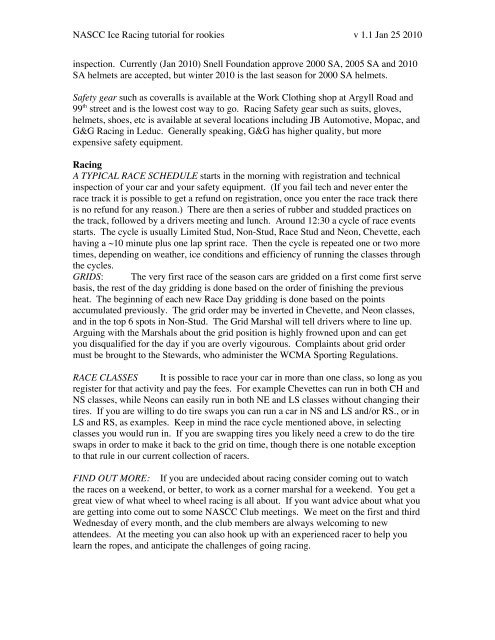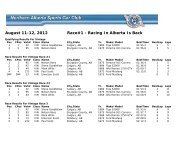Ice Racing 101 - nascc
Ice Racing 101 - nascc
Ice Racing 101 - nascc
Create successful ePaper yourself
Turn your PDF publications into a flip-book with our unique Google optimized e-Paper software.
NASCC <strong>Ice</strong> <strong>Racing</strong> tutorial for rookies v 1.1 Jan 25 2010<br />
inspection. Currently (Jan 2010) Snell Foundation approve 2000 SA, 2005 SA and 2010<br />
SA helmets are accepted, but winter 2010 is the last season for 2000 SA helmets.<br />
Safety gear such as coveralls is available at the Work Clothing shop at Argyll Road and<br />
99 th street and is the lowest cost way to go. <strong>Racing</strong> Safety gear such as suits, gloves,<br />
helmets, shoes, etc is available at several locations including JB Automotive, Mopac, and<br />
G&G <strong>Racing</strong> in Leduc. Generally speaking, G&G has higher quality, but more<br />
expensive safety equipment.<br />
<strong>Racing</strong><br />
A TYPICAL RACE SCHEDULE starts in the morning with registration and technical<br />
inspection of your car and your safety equipment. (If you fail tech and never enter the<br />
race track it is possible to get a refund on registration, once you enter the race track there<br />
is no refund for any reason.) There are then a series of rubber and studded practices on<br />
the track, followed by a drivers meeting and lunch. Around 12:30 a cycle of race events<br />
starts. The cycle is usually Limited Stud, Non-Stud, Race Stud and Neon, Chevette, each<br />
having a ~10 minute plus one lap sprint race. Then the cycle is repeated one or two more<br />
times, depending on weather, ice conditions and efficiency of running the classes through<br />
the cycles.<br />
GRIDS: The very first race of the season cars are gridded on a first come first serve<br />
basis, the rest of the day gridding is done based on the order of finishing the previous<br />
heat. The beginning of each new Race Day gridding is done based on the points<br />
accumulated previously. The grid order may be inverted in Chevette, and Neon classes,<br />
and in the top 6 spots in Non-Stud. The Grid Marshal will tell drivers where to line up.<br />
Arguing with the Marshals about the grid position is highly frowned upon and can get<br />
you disqualified for the day if you are overly vigourous. Complaints about grid order<br />
must be brought to the Stewards, who administer the WCMA Sporting Regulations.<br />
RACE CLASSES It is possible to race your car in more than one class, so long as you<br />
register for that activity and pay the fees. For example Chevettes can run in both CH and<br />
NS classes, while Neons can easily run in both NE and LS classes without changing their<br />
tires. If you are willing to do tire swaps you can run a car in NS and LS and/or RS., or in<br />
LS and RS, as examples. Keep in mind the race cycle mentioned above, in selecting<br />
classes you would run in. If you are swapping tires you likely need a crew to do the tire<br />
swaps in order to make it back to the grid on time, though there is one notable exception<br />
to that rule in our current collection of racers.<br />
FIND OUT MORE: If you are undecided about racing consider coming out to watch<br />
the races on a weekend, or better, to work as a corner marshal for a weekend. You get a<br />
great view of what wheel to wheel racing is all about. If you want advice about what you<br />
are getting into come out to some NASCC Club meetings. We meet on the first and third<br />
Wednesday of every month, and the club members are always welcoming to new<br />
attendees. At the meeting you can also hook up with an experienced racer to help you<br />
learn the ropes, and anticipate the challenges of going racing.



